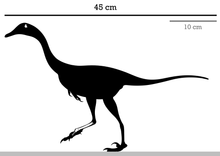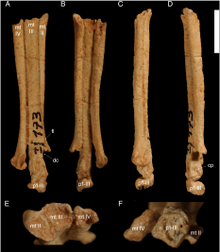Hulsanpes
| Hulsanpes | |
|---|---|

| |
| Skeletal diagram of ZPAL MgD-I/173 | |
| Scientific classification | |
| Domain: | Eukaryota |
| Kingdom: | Animalia |
| Phylum: | Chordata |
| Clade: | Dinosauria |
| Clade: | Saurischia |
| Clade: | Theropoda |
| Family: | †Dromaeosauridae |
| Subfamily: | †Halszkaraptorinae |
| Genus: | †Hulsanpes Osmólska, 1982 |
| Type species | |
| †Hulsanpes perlei Osmólska, 1982
| |
Hulsanpes (IPA:
History of discovery

The first
Description


The holotype specimen is represented by a very small immature individual and therefore all the available data is somewhat limited. The roughly textured bones are indicators of an early stage of life, probably a post-hatchling chick. The genus itself can be distinguished in having the contact area of metatarsal III and IV straight in a frontal view and the lower end of metatarsal IV projected to the lower lateral side.[2]
Overall, the preserved right
The partial
Classification

When first described in 1982, Osmólska tentatively placed Hulsanpes within the
After several inconsistencies surrounding the placement of the genus, in
| Dromaeosauridae |
| ||||||||||||||||||||||||||||||||||||||||||||||||
Paleobiology
Hulsanpes has been re-classified as a halszkaraptorine taxon, updating various aspects about the life-style of these animals. Hulsanpes had a similar life-style to those of the modern-day
Paleoecology
The holotype specimen was recovered from the
See also
References
- ^ .
- ^ PMID 29868277.
- ISBN 052154582X. Archived from the original(PDF) on 2006-11-10. Retrieved 2020-03-27.
- ^ Senter, P.; Barsbold, R.; Britt, B. B; Burnham, D. A. (2004). "Systematics and evolution of Dromaeosauridae (Dinosauria, Theropoda)". Bulletin of Gunma Natural History Museum. 8: 1–20.
- ISBN 9789400756373.
- ^ S2CID 4471941.
- PMID 32140312.
- .
- .





